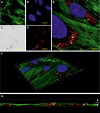Optical Microscopy Systems for the Detection of Unlabeled Nanoparticles
- PMID: 35599750
- PMCID: PMC9115408
- DOI: 10.2147/IJN.S355007
Optical Microscopy Systems for the Detection of Unlabeled Nanoparticles
Abstract
Label-free detection of nanoparticles is essential for a thorough evaluation of their cellular effects. In particular, nanoparticles intended for medical applications must be carefully analyzed in terms of their interactions with cells, tissues, and organs. Since the labeling causes a strong change in the physicochemical properties and thus also alters the interactions of the particles with the surrounding tissue, the use of fluorescently labeled particles is inadequate to characterize the effects of unlabeled particles. Further, labeling may affect cellular uptake and biocompatibility of nanoparticles. Thus, label-free techniques have been recently developed and implemented to ensure a reliable characterization of nanoparticles. This review provides an overview of frequently used label-free visualization techniques and highlights recent studies on the development and usage of microscopy systems based on reflectance, darkfield, differential interference contrast, optical coherence, photothermal, holographic, photoacoustic, total internal reflection, surface plasmon resonance, Rayleigh light scattering, hyperspectral and reflectance structured illumination imaging. Using these imaging modalities, there is a strong enhancement in the reliability of experiments concerning cellular uptake and biocompatibility of nanoparticles, which is crucial for preclinical evaluations and future medical applications.
Keywords: holotomography; label free imaging; nanoparticle detection; non-fluorescent imaging; reflectance imaging; scattering microscopy.
© 2022 Friedrich et al.
Conflict of interest statement
The authors report no conflicts of interest in this work.
Figures






Similar articles
-
Noble metals on the nanoscale: optical and photothermal properties and some applications in imaging, sensing, biology, and medicine.Acc Chem Res. 2008 Dec;41(12):1578-86. doi: 10.1021/ar7002804. Acc Chem Res. 2008. PMID: 18447366
-
Individual Plasmonic Nanoprobes for Biosensing and Bioimaging: Recent Advances and Perspectives.Small. 2021 Feb;17(8):e2004287. doi: 10.1002/smll.202004287. Epub 2021 Feb 1. Small. 2021. PMID: 33522074 Review.
-
Imaging non-fluorescent nanoparticles in living cells with wavelength-dependent differential interference contrast microscopy and planar illumination microscopy.Methods Mol Biol. 2013;931:169-86. doi: 10.1007/978-1-62703-056-4_10. Methods Mol Biol. 2013. PMID: 23027004
-
Reflectance structured illumination imaging of internalized cerium oxide nanoparticles modulating dose-dependent reactive oxygen species in breast cancer cells.Biochem Biophys Rep. 2020 Feb 14;22:100745. doi: 10.1016/j.bbrep.2020.100745. eCollection 2020 Jul. Biochem Biophys Rep. 2020. PMID: 32099911 Free PMC article.
-
Nanoparticles for photoacoustic imaging.Wiley Interdiscip Rev Nanomed Nanobiotechnol. 2009 Jul-Aug;1(4):360-8. doi: 10.1002/wnan.42. Wiley Interdiscip Rev Nanomed Nanobiotechnol. 2009. PMID: 20049803 Review.
Cited by
-
Characterization Methods for Nanoparticle-Skin Interactions: An Overview.Life (Basel). 2024 May 8;14(5):599. doi: 10.3390/life14050599. Life (Basel). 2024. PMID: 38792620 Free PMC article. Review.
-
Microlens-Assisted Light-Scattering Imaging of Plasmonic Nanoparticles at the Single Particle Level.Biosensors (Basel). 2023 Sep 6;13(9):871. doi: 10.3390/bios13090871. Biosensors (Basel). 2023. PMID: 37754105 Free PMC article.
-
Nanovesicles and Human Skin Interaction: A Comparative Ex-Vivo Study.Nanomaterials (Basel). 2025 Jun 16;15(12):937. doi: 10.3390/nano15120937. Nanomaterials (Basel). 2025. PMID: 40559300 Free PMC article.
-
Comparison of Gold Nanoparticle and Fluorophore-conjugated Antibodies for Labeling Epitopes in Permeabilized Cells.J Histochem Cytochem. 2025 May-Jun;73(5-6):223-236. doi: 10.1369/00221554251348502. Epub 2025 Jun 24. J Histochem Cytochem. 2025. PMID: 40552463 Free PMC article.
-
Identification of Zirconia Particle Uptake in Human Osteoblasts by ToF-SIMS Analysis and Particle-Size Effects on Cell Metabolism.Nanomaterials (Basel). 2022 Dec 1;12(23):4272. doi: 10.3390/nano12234272. Nanomaterials (Basel). 2022. PMID: 36500895 Free PMC article.
References
Publication types
MeSH terms
LinkOut - more resources
Full Text Sources

